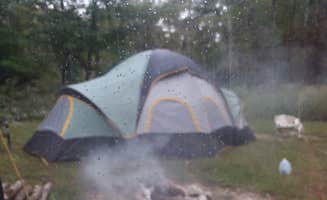Tent camping near Lake Ozark, Missouri provides access to the Lake of the Ozarks, a 54,000-acre reservoir with 1,150 miles of shoreline in central Missouri. Conservation areas in the region sit on hilly terrain with elevations ranging between 600-900 feet. Summer temperatures regularly exceed 90°F with high humidity, while spring and fall offer milder camping conditions between 50-75°F.
What to do
Fishing opportunities: McCubbins Point offers direct access to Lake of the Ozarks for fishing. According to one visitor, the area has a "public boat ramp" making it convenient for anglers to launch small watercraft.
River exploration: Paydown Access provides secluded camping with Gasconade River access. A camper noted it's "beautiful, very secluded" and makes "a great spot when the weather cooperates," perfect for paddlers wanting to explore less crowded waterways.
Target practice: Scrivner Road Conservation Area offers a combination of outdoor activities including a shooting range. A reviewer described it as "a Swiss Army knife of rugged off the path camping" with a "handgun and rifle range with vault toilets" for those wanting to practice shooting during their camping trip.
What campers like
Privacy between sites: Many conservation area campgrounds offer well-spaced sites. At Fiery Fork Conservation Area, one camper mentioned they "could see [neighbors] with our eyeballs but they were perfect neighbors and we didn't hear a peep other than their generator for a bit."
Multi-activity options: The diverse landscape allows for various outdoor pursuits. A camper at Scrivner Road Conservation Area appreciated that "Rivers, Lakes, Gun range, Horses and hiking can all be enjoyed here," making it possible to experience different activities without relocating camp.
Natural beaches: Osage-Tavern Access receives praise for its water access. One visitor observed it has "probably about 12-15 sites, small, just fire pits" and is "right along the river so nice if your looking for water," providing natural shorelines for swimming and relaxation.
What you should know
Limited facilities: Most tent camping areas have minimal amenities. At Pikes Camp, a camper described finding "a shaded grassy area for camping. No power vault toilets," typical of conservation areas in the region.
Road conditions: Access roads to more remote sites can be challenging. One camper at Fiery Fork Conservation Area warned "the road down was very sketchy for my 2008 Mazda 3," indicating sedans and low-clearance vehicles may struggle on some access roads.
Cell service gaps: Expect communication limitations at most sites. A visitor to Fiery Fork Conservation Area noted "there was absolutely NO service there which was good to get away, but bad in an emergency" for AT&T users, recommending backup communication plans.
Trash management: No garbage collection exists at most sites. One camper warned that at Fiery Fork Conservation Area, "unfortunately there was some spots with trash, especially around the fire. There is no dumpster so be prepared to take your trash with you."
Tips for camping with families
Riverside play areas: Natural beaches provide recreation for children. A parent camping at Fiery Fork Conservation Area found "there is quite a bit of 'beach' at the river access for them to play and see nature," offering built-in entertainment for kids.
Wildlife viewing opportunities: Many sites offer chances to observe local animals. Families at Fiery Fork Conservation Area reported seeing "Armadillos, deer, and a few different bird types could be found easily," providing educational nature encounters.
Visit timing: Bledsoe Ferry receives praise as "a great place for the family," but across all sites, shoulder seasons (spring/fall) offer more solitude. One camper at Osage-Tavern Access mentioned arriving "at 6 on a Saturday (post labor day) and plenty of sites available," indicating less competition for spots outside peak summer months.
Local safety patrols: Some areas receive regular security checks. A camper at Paydown Access noted "The police drove by around 11 pm which had us wondering if some people hang out and party there on occasion," suggesting periodic monitoring of camping areas.
Tips from RVers
Size restrictions: Most conservation areas have limited space for larger rigs. At Fiery Fork Conservation Area, a camper recommended "smaller RVs due to the 2 miles of gravel and high water areas you go through to get there," as access roads and camping areas aren't designed for big vehicles.
Weather monitoring: Seasonal flooding can affect accessibility. One RVer at Fiery Fork Conservation Area warned "If the waters too high, there's a bridge into the site that could be flooded so watch the weather," suggesting checking conditions before attempting access with larger vehicles.


